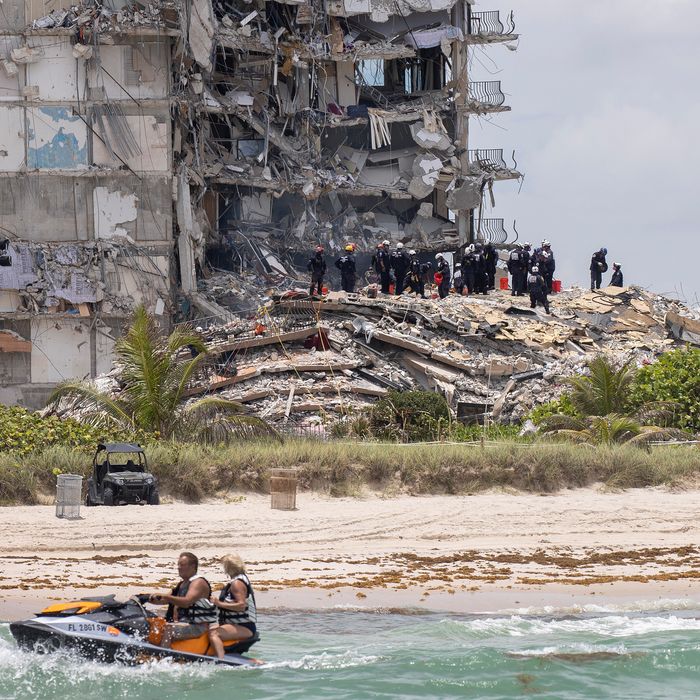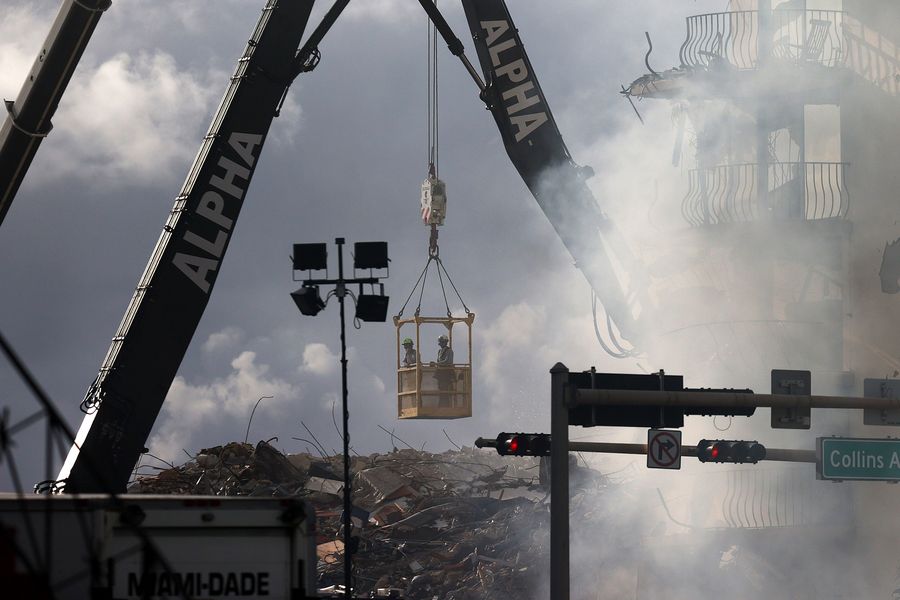
Just before midnight Saturday, Jonathan Hamilton began scaling a mountain of uneven concrete slabs where Champlain Towers South in Surfside, Florida, once stood. A heavy-rigging specialist with Tampa Fire Rescue, he climbed over dozens of condos that had stretched 12 stories into the sky but were now compressed into 50 feet of tight layers. He navigated around fangs of steel and columns of smoke from a fire roaring somewhere deep in the pile while rain fell from above.
“In this world, we say these piles are alive. They’re constantly moving, constantly shifting, like pieces of a jigsaw puzzle,” he said.
Once he reached the summit, Hamilton and other members of Florida Task Force 3, an elite unit usually deployed for hurricanes, began their assault.
“We come in with jack hammers, rebar cutters, air chisels, sledge hammers, and bucket brigades to remove material,” said Nelson Garcia, a rescue specialist. “It’s taking big rocks and making small rocks, taking big slabs and making small slabs for a crane to carry.”
Sometimes the pile groans under the attack. “We detect sounds all the time, but that doesn’t mean they are humans,” said FEMA official Margarita Castro. Specialists use sonar and microphones to listen for faint sounds of life. “The pile makes sounds from debris or metal; it could be anything, but we inspect everything.”
The pile is packed so tightly that it’s difficult for rescue workers to enter an alcove where someone may still be alive, said Dr. Alison Thompson, founder of Third Wave Volunteers, who are working at the site. “It’s like standing at the gates of hell, but there’s no door,” she said.
Over the weekend, workers cut a trench into the pile measuring 125 feet long, 20 feet wide, and 40 feet deep. The effort yielded four bodies and “additional human remains,” said Miami-Dade mayor Daniella Levine Cava during a Sunday press conference. The death toll as of Tuesday morning was 11 after more bodies were recovered. No one has been found alive since Friday, but the effort is still in the rescue phase.
The work has carried on nonstop since early Thursday morning when the building collapsed. Some 400 search-and-rescue personnel rotate on 12-hour shifts, 24 hours a day, with over 200 working on the pile at one time, according to Alan Cominsky, the Miami-Dade fire-rescue chief, who knows one of the more than 150 missing. Even so, the pace can’t go fast enough for some.
“I’ve had feelings of storming the debris and ripping at the cement and pilons until my hands bleed,” Thompson said via email. “But our reality is we can’t have 10,000 people on an unstable rubble in rain and lightning with wind and flying debris and small fires burning inside.”
Thompson, who has decades of aid and relief experience from Syria to Haiti, said this was the only disaster in the past 20 years that transported her back to working rescue and recovery after 9/11, with pieces of people’s lives — a shoe, a bank statement, a photo of a child — strewn throughout the wreckage. “Even though you can’t see the death,” she said by phone, “you can smell the death.”
Seaside condos such as Champlain Towers festoon the eastern coast of Florida, offering sweeping views and palm-tree lined pool decks. Just blocks south of the catastrophe, families were pushing strollers and wheeling coolers for an afternoon on the white South Florida sand.
“I knew it was there, but when you see it, it’s a huge paradox,” said Garcia of the nearby ocean. “You’re on the top of this pile, and right there is this beauty of the beach.”
Thompson is still holding out hope that teams could still find someone alive. “I’ve been in so many rescues, like in Haiti, when on the sixth or the tenth day you find someone or pull out people two weeks later.”
Tim Venables of Paraguay did not have such hope. Holding his head in one hand, he reached out to touch a photo of Sophia López Moreira that was posted on a fence across the street from the disaster site that families have turned into a memorial for the missing and the dead. “My wife went to school with Sophia. They knew each other all their lives,” said Venables, who was in Miami on a previously scheduled trip. López Moreira, the sister of Paraguay’s First Lady, is missing beneath the rubble along with her husband and their three young children. “I just hope they didn’t suffer,” he said.





